0 前言
map 是一种如此经典的数据结构,各种语言中都对 map 着一套宏观流程相似、但技术细节百花齐放的实现方式.
古语有云,大道至简,但这更多体现在原理和使用层面,从另一个角度而言,在认知上越基础的东西反而往往有着越复杂的实现细节.
那么,诸位英雄好汉中又有哪几位有勇气随我一同深入 golang 的 map 源码,抱着不通透不罢休的态度,对其底层原理进行一探究竟呢?
1 基本用法
1.1 概述
map 又称字典,是一种常用的数据结构,核心特征包含下述三点:
(1)存储基于 key-value 对映射的模式;
(2)基于 key 维度实现存储数据的去重;
(3)读、写、删操作控制,时间复杂度 O(1).
1.2 初始化
1.2.1 几种初始化方法
golang 中,对 map 的初始化分为以下几种方式:
myMap1 := make(map[int]int,2)通过 make 关键字进行初始化,同时指定 map 预分配的容量.
myMap2 := make(map[int]int)通过 make 关键字进行初始化,不显式声明容量,因此默认容量 为 0.
myMap3 :=map[int]int{
1:2,
3:4,
}初始化操作连带赋值,一气呵成.
1.2.2 key 的类型要求
map 中,key 的数据类型必须为可比较的类型,需要关注,不可比较的类型包括:切片、map 和函数.
1.3 读
读 map 分为下面两种方式:
v1 := myMap[10]第一种方式是直接读,倘若 key 存在,则获取到对应的 val,倘若 key 不存在或者 map 未初始化,会返回 val 类型的零值作为兜底.
v2,ok := myMap[10]第二种方式是读的同时添加一个 bool 类型的 flag 标识是否读取成功. 倘若 ok == false,说明读取失败, key 不存在,或者 map 未初始化.
此处同一种语法能够实现不同返回值类型的适配,是由于代码在汇编时,会根据返回参数类型的区别,映射到不同的实现方法.
1.4 写
myMap[5] = 6写操作的语法如上. 须注意的一点是,倘若 map 未初始化,直接执行写操作会导致 panic:
const plainError string
panic(plainError("assignment to entry in nil map"))1.5 删
delete(myMap,5)执行 delete 方法时,倘若 key 存在,则会从 map 中将对应的 key-value 对删除;倘若 key 不存在或 map 未初始化,则方法直接结束,不会产生显式提示.
1.6 遍历
遍历分为下面两种方式:
for k,v := range myMap{
// ...
}基于 k,v 依次承接 map 中的 key-value 对;
for k := range myMap{
// ...
}基于 k 依次承接 map 中的 key,不关注 val 的取值.
需要注意的是,在执行 map 遍历操作时,获取的 key-value 对并没有一个固定的顺序,因此前后两次遍历顺序可能存在差异.
1.7 并发冲突
map 不是并发安全的数据结构,倘若存在并发读写行为,会抛出 fatal error.
具体规则是:
(1)并发读没有问题;
(2)并发读写中的“写”是广义上的,包含写入、更新、删除等操作;
(3)读的时候发现其他 goroutine 在并发写,抛出 fatal error;
(4)写的时候发现其他 goroutine 在并发写,抛出 fatal error.
fatal("concurrent map read and map write")
fatal("concurrent map writes")需要关注,此处并发读写会引发 fatal error,是一种比 panic 更严重的错误,无法使用 recover 操作捕获.
2 核心原理
map 又称为 hash map,在算法上基于 hash 实现 key 的映射和寻址;在数据结构上基于桶数组实现 key-value 对的存储.
以一组 key-value 对写入 map 的流程为例进行简述:
(1)通过哈希方法取得 key 的 hash 值;
(2)hash 值对桶数组长度取模,确定其所属的桶;
(3)在桶中插入 key-value 对.
hash 的性质,保证了相同的 key 必然产生相同的 hash 值,因此能映射到相同的桶中,通过桶内遍历的方式锁定对应的 key-value 对.
因此,只要在宏观流程上,控制每个桶中 key-value 对的数量,就能保证 map 的几项操作都限制为常数级别的时间复杂度.
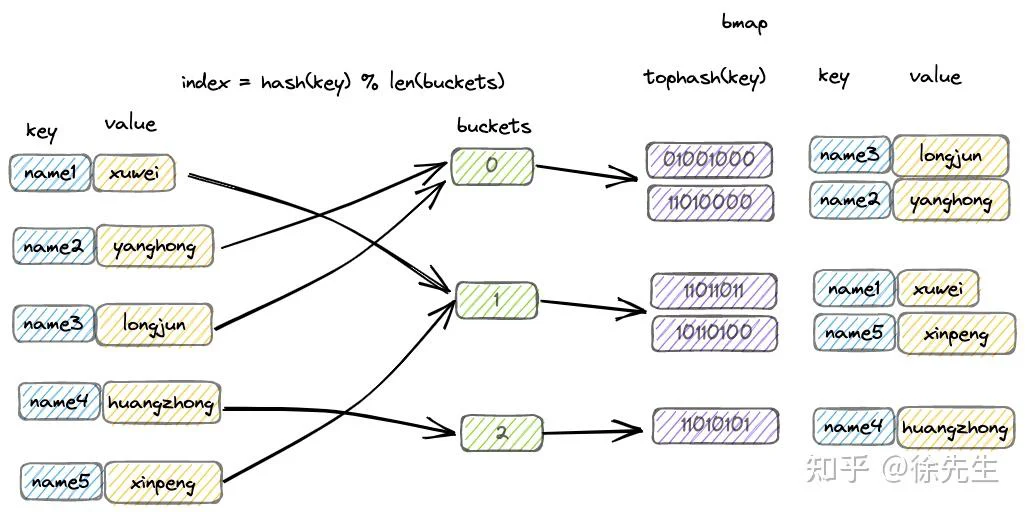
2.1 hash
hash 译作散列,是一种将任意长度的输入压缩到某一固定长度的输出摘要的过程,由于这种转换属于压缩映射,输入空间远大于输出空间,因此不同输入可能会映射成相同的输出结果. 此外,hash在压缩过程中会存在部分信息的遗失,因此这种映射关系具有不可逆的特质.
(1)hash 的可重入性:相同的 key,必然产生相同的 hash 值;
(2)hash 的离散性:只要两个 key 不相同,不论其相似度的高低,产生的 hash 值会在整个输出域内均匀地离散化;
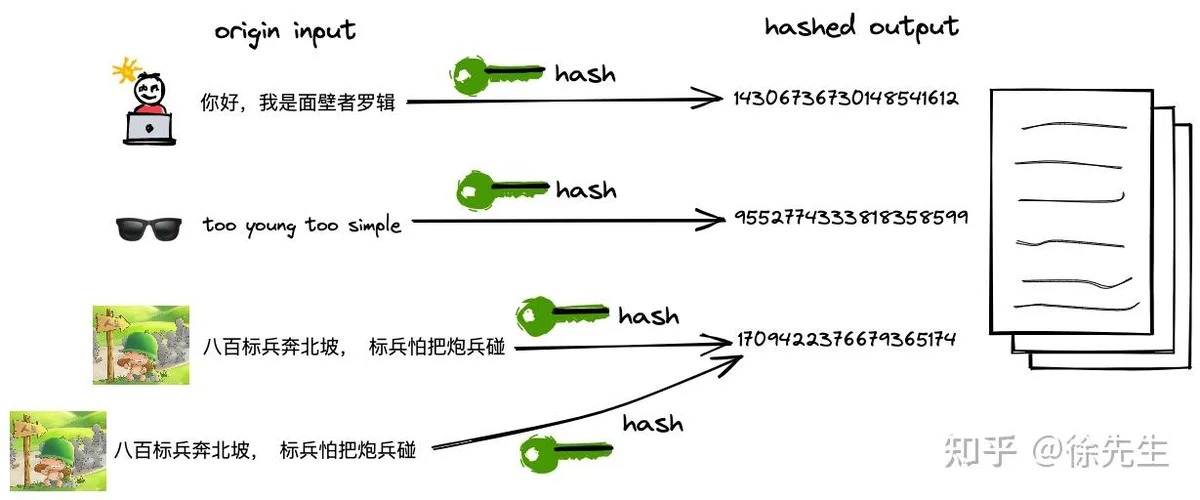
(3)hash 的单向性:企图通过 hash 值反向映射回 key 是无迹可寻的.

(4)hash 冲突:由于输入域(key)无穷大,输出域(hash 值)有限,因此必然存在不同 key 映射到相同 hash 值的情况,称之为 hash 冲突.
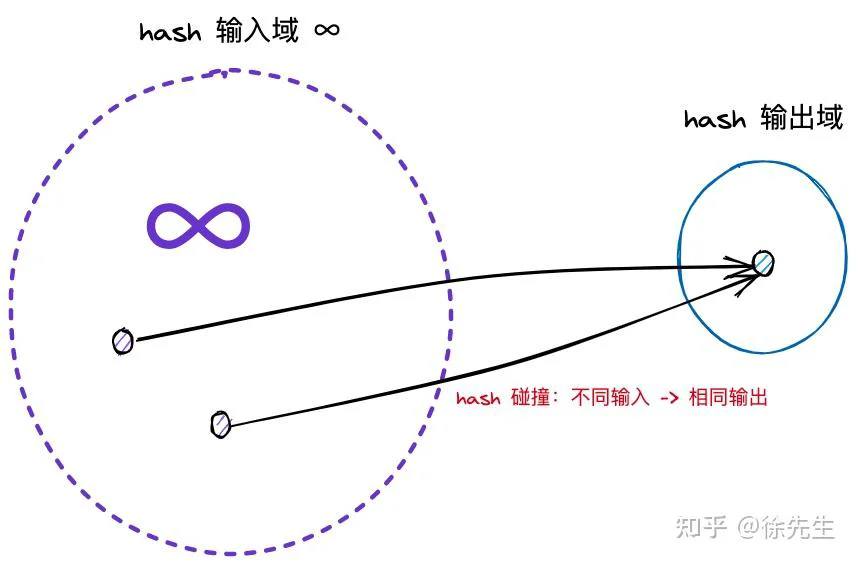
2.2 桶数组
map 中,会通过长度为 2 的整数次幂的桶数组进行 key-value 对的存储:
(1)每个桶固定可以存放 8 个 key-value 对;
(2)倘若超过 8 个 key-value 对打到桶数组的同一个索引当中,此时会通过创建桶链表的方式来化解这一问题.
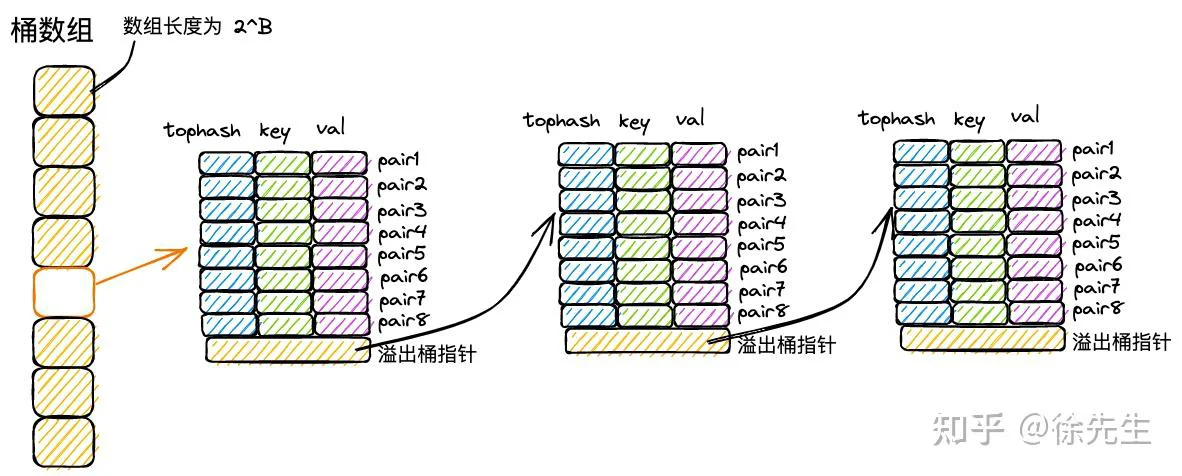
2.3 map 解决 hash 冲突
首先,由于 hash 冲突的存在,不同 key 可能存在相同的 hash 值;
再者,hash 值会对桶数组长度取模,因此不同 hash 值可能被打到同一个桶中.
综上,不同的 key-value 可能被映射到 map 的同一个桶当中.
此时最经典的解决手段分为两种:拉链法和开放寻址法.
(1)拉链法
拉链法中,将命中同一个桶的元素通过链表的形式进行链接,因此很便于动态扩展.
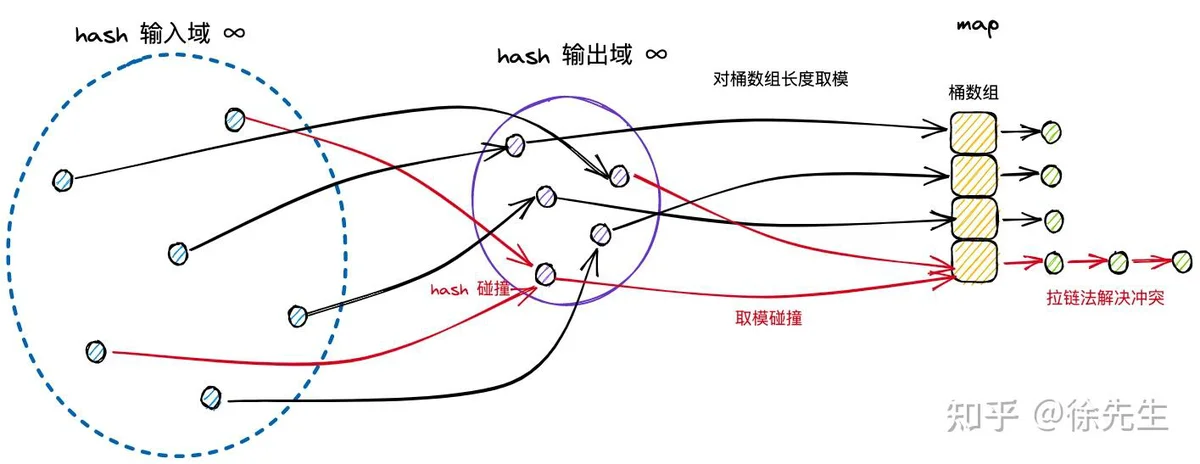
(2)开放寻址法
开放寻址法中,在插入新条目时,会基于一定的探测策略持续寻找,直到找到一个可用于存放数据的空位为止.
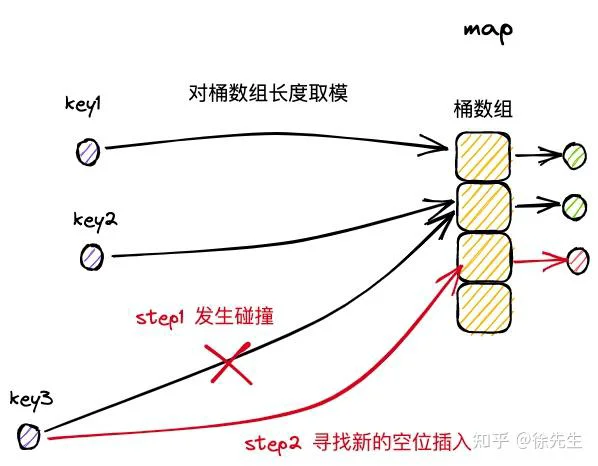
对标拉链还有开放寻址法,两者的优劣对比:
| 方法 | 优点 |
| 拉链法 | 简单常用;无需预先为元素分配内存. |
| 开放寻址法 | 无需额外的指针用于链接元素;内存地址完全连续,可以基于局部性原理,充分利用 CPU 高速缓存. |
在 map 解决 hash /分桶 冲突问题时,实际上结合了拉链法和开放寻址法两种思路. 以 map 的插入写流程为例,进行思路阐述:
(1)桶数组中的每个桶,严格意义上是一个单向桶链表,以桶为节点进行串联;
(2)每个桶固定可以存放 8 个 key-value 对;
(3)当 key 命中一个桶时,首先根据开放寻址法,在桶的 8 个位置中寻找空位进行插入;
(4)倘若桶的 8 个位置都已被占满,则基于桶的溢出桶指针,找到下一个桶,重复第(3)步;
(5)倘若遍历到链表尾部,仍未找到空位,则基于拉链法,在桶链表尾部续接新桶,并插入 key-value 对.
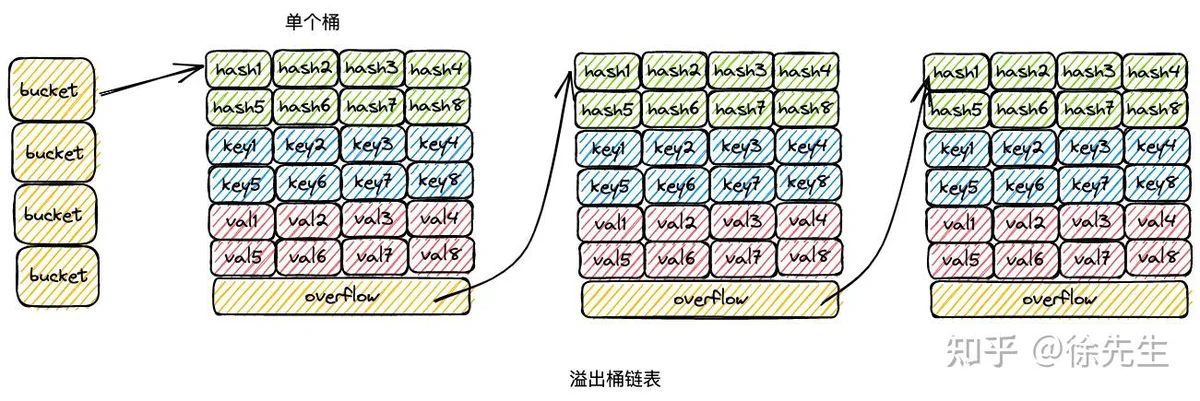
2.4 扩容优化性能
倘若 map 的桶数组长度固定不变,那么随着 key-value 对数量的增长,当一个桶下挂载的 key-value 达到一定的量级,此时操作的时间复杂度会趋于线性,无法满足诉求.
因此在实现上,map 桶数组的长度会随着 key-value 对数量的变化而实时调整,以保证每个桶内的 key-value 对数量始终控制在常量级别,满足各项操作为 O(1) 时间复杂度的要求.
map 扩容机制的核心点包括:
(1)扩容分为增量扩容和等量扩容;
(2)当桶内 key-value 总数/桶数组长度 > 6.5 时发生增量扩容,桶数组长度增长为原值的两倍;
(3)当桶内溢出桶数量大于等于 2^B 时( B 为桶数组长度的指数,B 最大取 15),发生等量扩容,桶的长度保持为原值;
(4)采用渐进扩容的方式,当桶被实际操作到时,由使用者负责完成数据迁移,避免因为一次性的全量数据迁移引发性能抖动.
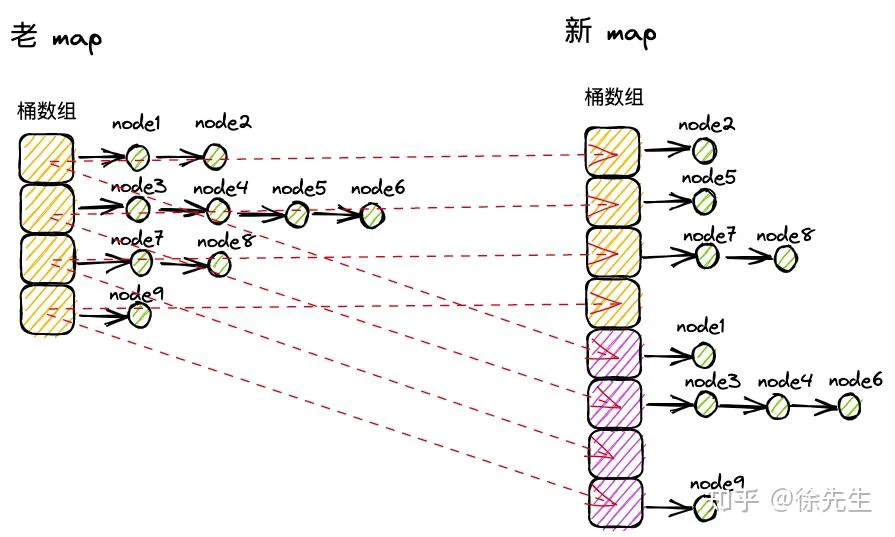
3 数据结构
3.1 hmap
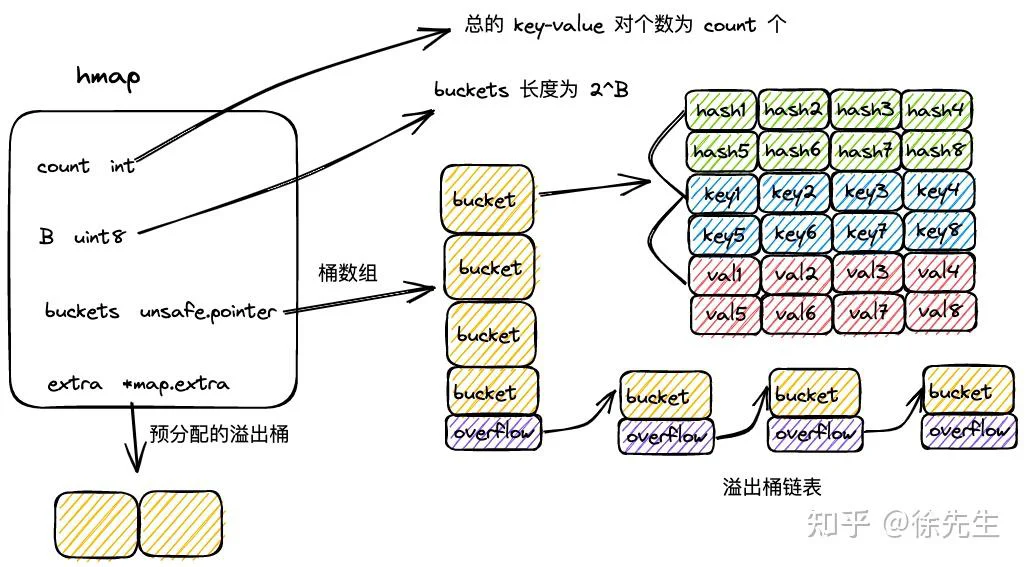
type hmap struct {
count int
flags uint8
B uint8
noverflow uint16
hash0 uint32
buckets unsafe.Pointer
oldbuckets unsafe.Pointer
nevacuate uintptr
extra *mapextra
}(1)count:map 中的 key-value 总数;
(2)flags:map 状态标识,可以标识出 map 是否被 goroutine 并发读写;
(3)B:桶数组长度的指数,桶数组长度为 2^B;
(4)noverflow:map 中溢出桶的数量;
(5)hash0:hash 随机因子,生成 key 的 hash 值时会使用到;
(6)buckets:桶数组;
(7)oldbuckets:扩容过程中老的桶数组;
(8)nevacuate:扩容时的进度标识,index 小于 nevacuate 的桶都已经由老桶转移到新桶中;
(9)extra:预申请的溢出桶.
3.2 mapextra
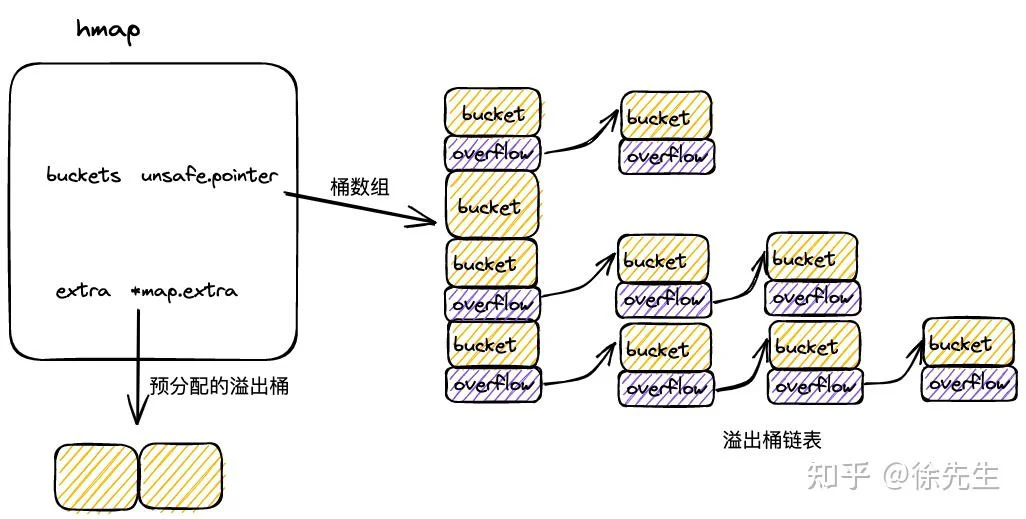
type mapextra struct {
overflow *[]*bmap
oldoverflow *[]*bmap
nextOverflow *bmap
}在 map 初始化时,倘若容量过大,会提前申请好一批溢出桶,以供后续使用,这部分溢出桶存放在 hmap.mapextra 当中:
(1)mapextra.overflow:供桶数组 buckets 使用的溢出桶;
(2)mapextra.oldoverFlow: 扩容流程中,供老桶数组 oldBuckets 使用的溢出桶;
(3)mapextra.nextOverflow:下一个可用的溢出桶.
3.3 bmap
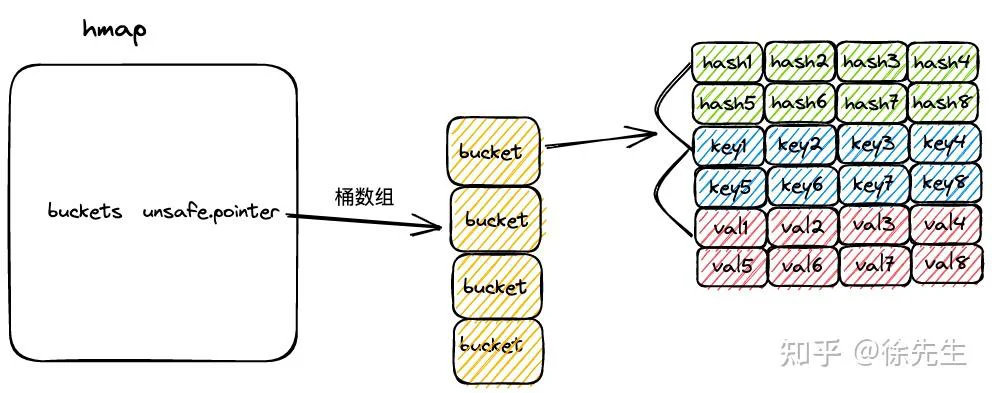
const bucketCnt = 8
type bmap struct {
tophash [bucketCnt]uint8
}(1)bmap 就是 map 中的桶,可以存储 8 组 key-value 对的数据,以及一个指向下一个溢出桶的指针;
(2)每组 key-value 对数据包含 key 高 8 位 hash 值 tophash,key 和 val 三部分;
(3)在代码层面只展示了 tophash 部分,但由于 tophash、key 和 val 的数据长度固定,因此可以通过内存地址偏移的方式寻找到后续的 key 数组、val 数组以及溢出桶指针;
(4)为方便理解,把完整的 bmap 类声明代码补充如下:
type bmap struct {
tophash [bucketCnt]uint8
keys [bucketCnt]T
values [bucketCnt]T
overflow uint8
}4 构造方法
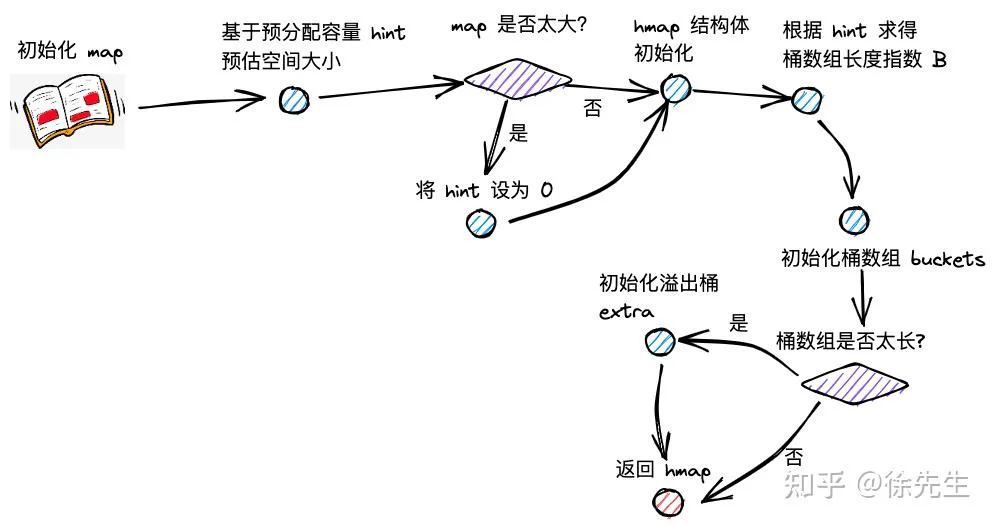
创建 map 时,实际上会调用 runtime/map.go 文件中的 makemap 方法,下面对源码展开分析:
4.1 makemap
方法主干源码一览:
func makemap(t *maptype, hint int, h *hmap) *hmap {
mem, overflow := math.MulUintptr(uintptr(hint), t.bucket.size)
if overflow || mem > maxAlloc {
hint = 0
}
if h == nil {
h = new(hmap)
}
h.hash0 = fastrand()
B := uint8(0)
for overLoadFactor(hint, B) {
B++
}
h.B = B
if h.B != 0 {
var nextOverflow *bmap
h.buckets, nextOverflow = makeBucketArray(t, h.B, nil)
if nextOverflow != nil {
h.extra = new(mapextra)
h.extra.nextOverflow = nextOverflow
}
}
return(1)hint 为 map 拟分配的容量;在分配前,会提前对拟分配的内存大小进行判断,倘若超限,会将 hint 置为零;
mem, overflow := math.MulUintptr(uintptr(hint), t.bucket.size)
if overflow || mem > maxAlloc {
hint = 0
}(2)通过 new 方法初始化 hmap;
if h == nil {
h = new(hmap)
}(3)调用 fastrand,构造 hash 因子:hmap.hash0;
h.hash0 = fastrand()(4)大致上基于 log2(B) >= hint 的思路(具体见 4.2 小节 overLoadFactor 方法的介绍),计算桶数组的容量 B;
B := uint8(0)
for overLoadFactor(hint, B) {
B++
}
h.B =(5)调用 makeBucketArray 方法,初始化桶数组 hmap.buckets;
var nextOverflow *bmap
h.buckets, nextOverflow = makeBucketArray(t, h.B, n(6)倘若 map 容量较大,会提前申请一批溢出桶 hmap.extra.
if nextOverflow != nil {
h.extra = new(mapextra)
h.extra.nextOverflow = nextOverflow
}4.2 overLoadFactor
通过 overLoadFactor 方法,对 map 预分配容量和桶数组长度指数进行判断,决定是否仍需要增长 B 的数值:
const loadFactorNum = 13
const loadFactorDen = 2
const goarch.PtrSize = 8
const bucketCnt = 8
func overLoadFactor(count int, B uint8) bool {
return count > bucketCnt && uintptr(count) > loadFactorNum*(bucketShift(B)/loadFactorDen)
}
func bucketShift(b uint8) uintptr {
return uintptr(1) << (b & (goarch.PtrSize*8 - 1))(1)倘若 map 预分配容量小于等于 8,B 取 0,桶的个数为 1;
(2)保证 map 预分配容量小于等于桶数组长度 * 6.5.
map 预分配容量、桶数组长度指数、桶数组长度之间的关系如下表:
| kv 对数量 | 桶数组长度指数 B | 桶数组长度 2^B |
| 0 ~ 8 | 0 | 1 |
| 9 ~ 13 | 1 | 2 |
| 14 ~ 26 | 2 | 4 |
| 27 ~ 52 | 3 | 8 |
| 2^(B-1) * 6.5+1 ~ 2^B*6.5 | B | 2^B |
4.3 makeBucketArray
makeBucketArray 方法会进行桶数组的初始化,并根据桶的数量决定是否需要提前作溢出桶的初始化. 方法主干代码如下:
func makeBucketArray(t *maptype, b uint8, dirtyalloc unsafe.Pointer) (buckets unsafe.Pointer, nextOverflow *bmap) {
base := bucketShift(b)
nbuckets := base
if b >= 4 {
nbuckets += bucketShift(b - 4)
}
buckets = newarray(t.bucket, int(nbuckets))
if base != nbuckets {
nextOverflow = (*bmap)(add(buckets, base*uintptr(t.bucketsize)))
last := (*bmap)(add(buckets, (nbuckets-1)*uintptr(t.bucketsize)))
last.setoverflow(t, (*bmap)(buckets))
}
return buckets, nextOverflow
}makeBucketArray 会为 map 的桶数组申请内存,在桶数组的指数 b >= 4时(桶数组的容量 >= 52 ),会需要提前创建溢出桶.
通过 base 记录桶数组的长度,不包含溢出桶;通过 nbuckets 记录累加上溢出桶后,桶数组的总长度.
base := bucketShift(b)
nbuckets := base
if b >= 4 {
nbuckets += bucketShift(b - 4)
}调用 newarray 方法为桶数组申请内存空间,连带着需要初始化的溢出桶:
buckets = newarray(t.bucket, int(nbuckets))倘若 base != nbuckets,说明需要创建溢出桶,会基于地址偏移的方式,通过 nextOverflow 指向首个溢出桶的地址.
if base != nbuckets {
nextOverflow = (*bmap)(add(buckets, base*uintptr(t.bucketsize)))
last := (*bmap)(add(buckets, (nbuckets-1)*uintptr(t.bucketsize)))
last.setoverflow(t, (*bmap)(buckets))
}
return buckets, nextOverflow倘若需要创建溢出桶,会在将最后一个溢出桶的 overflow 指针指向 buckets 数组,以此来标识申请的溢出桶已经用完.
func (b *bmap) setoverflow(t *maptype, ovf *bmap) {
*(**bmap)(add(unsafe.Pointer(b), uintptr(t.bucketsize)-goarch.PtrSize)) = ovf
}5 读流程
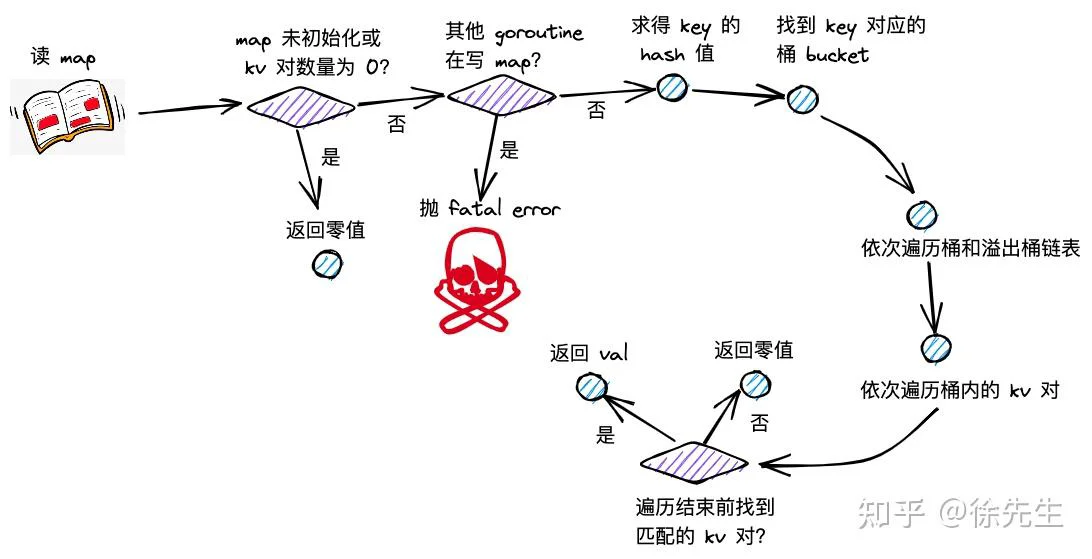
5.1 读流程梳理
map 读流程主要分为以下几步:
(1)根据 key 取 hash 值;
(2)根据 hash 值对桶数组取模,确定所在的桶;
(3)沿着桶链表依次遍历各个桶内的 key-value 对;
(4)命中相同的 key,则返回 value;倘若 key 不存在,则返回零值.
map 读操作最终会走进 runtime/map.go 的 mapaccess 方法中,下面开始阅读源码:
5.2 mapaccess 方法源码走读
func mapaccess1(t *maptype, h *hmap, key unsafe.Pointer) unsafe.Pointer {
if h == nil || h.count == 0 {
return unsafe.Pointer(&zeroVal[0])
}
if h.flags&hashWriting != 0 {
fatal("concurrent map read and map write")
}
hash := t.hasher(key, uintptr(h.hash0))
m := bucketMask(h.B)
b := (*bmap)(add(h.buckets, (hash&m)*uintptr(t.bucketsize)))
if c := h.oldbuckets; c != nil {
if !h.sameSizeGrow() {
m >>= 1
}
oldb := (*bmap)(add(c, (hash&m)*uintptr(t.bucketsize)))
if !evacuated(oldb) {
b = oldb
}
}
top := tophash(hash)
bucketloop:
for ; b != nil; b = b.overflow(t) {
for i := uintptr(0); i < bucketCnt; i++ {
if b.tophash[i] != top {
if b.tophash[i] == emptyRest {
break bucketloop
}
continue
}
k := add(unsafe.Pointer(b), dataOffset+i*uintptr(t.keysize))
if t.indirectkey() {
k = *((*unsafe.Pointer)(k))
}
if t.key.equal(key, k) {
e := add(unsafe.Pointer(b), dataOffset+bucketCnt*uintptr(t.keysize)+i*uintptr(t.elemsize))
if t.indirectelem() {
e = *((*unsafe.Pointer)(e))
}
return e
}
}
}
return unsafe.Pointer(&zeroVal[0])
}
func (h *hmap) sameSizeGrow() bool {
return h.flags&sameSizeGrow != 0
}
func evacuated(b *bmap) bool {
h := b.tophash[0]
return h > emptyOne && h < minTopHash
}(1)倘若 map 未初始化,或此时存在 key-value 对数量为 0,直接返回零值;
if h == nil || h.count == 0 {
return unsafe.Pointer(&zeroVal[0])
}(2)倘若发现存在其他 goroutine 在写 map,直接抛出并发读写的 fatal error;其中,并发写标记,位于 hmap.flags 的第 3 个 bit 位;
const hashWriting = 4
if h.flags&hashWriting != 0 {
fatal("concurrent map read and map write")
}(3)通过 maptype.hasher() 方法计算得到 key 的 hash 值,并对桶数组长度取模,取得对应的桶. 关于 hash 方法的内部实现,golang 并未暴露.
hash := t.hasher(key, uintptr(h.hash0))
m := bucketMask(h.B)
b := (*bmap)(add(h.buckets, (hash&m)*uintptr(t.bucketsize))其中,bucketMast 方法会根据 B 求得桶数组长度 - 1 的值,用于后续的 & 运算,实现取模的效果:
func bucketMask(b uint8) uintptr {
return bucketShift(b) - 1
}(4)在取桶时,会关注当前 map 是否处于扩容的流程,倘若是的话,需要在老的桶数组 oldBuckets 中取桶,通过 evacuated 方法判断桶数据是已迁到新桶还是仍存留在老桶,倘若仍在老桶,需要取老桶进行遍历.
if c := h.oldbuckets; c != nil {
if !h.sameSizeGrow() {
m >>= 1
}
oldb := (*bmap)(add(c, (hash&m)*uintptr(t.bucketsize)))
if !evacuated(oldb) {
b = oldb
}
}在取老桶前,会先判断 map 的扩容流程是否是增量扩容,倘若是的话,说明老桶数组的长度是新桶数组的一半,需要将桶长度值 m 除以 2.
const (
sameSizeGrow = 8
)
func (h *hmap) sameSizeGrow() bool {
return h.flags&sameSizeGrow != 0
}取老桶时,会调用 evacuated 方法判断数据是否已经迁移到新桶. 判断的方式是,取桶中首个 tophash 值,倘若该值为 2,3,4 中的一个,都代表数据已经完成迁移.
const emptyOne = 1
const evacuatedX = 2
const evacuatedY = 3
const evacuatedEmpty = 4
const minTopHash = 5
func evacuated(b *bmap) bool {
h := b.tophash[0]
return h > emptyOne && h < minTopHash
}(5)取 key hash 值的高 8 位值 top. 倘若该值 < 5,会累加 5,以避开 0 ~ 4 的取值. 因为这几个值会用于枚举,具有一些特殊的含义.
const minTopHash = 5
top := tophash(hash)
func tophash(hash uintptr) uint8 {
top := uint8(hash >> (goarch.PtrSize*8 - 8))
if top < minTopHash {
top += minTopHash
}
return top(6)开启两层 for 循环进行遍历流程,外层基于桶链表,依次遍历首个桶和后续的每个溢出桶,内层依次遍历一个桶内的 key-value 对.
bucketloop:
for ; b != nil; b = b.overflow(t) {
for i := uintptr(0); i < bucketCnt; i++ {
// ...
}
}
return unsafe.Pointer(&zeroVal[0])内存遍历时,首先查询高 8 位的 tophash 值,看是否和 key 的 top 值匹配.
倘若不匹配且当前位置 tophash 值为 0,说明桶的后续位置都未放入过元素,当前 key 在 map 中不存在,可以直接打破循环,返回零值.
const emptyRest = 0
if b.tophash[i] != top {
if b.tophash[i] == emptyRest {
break bucketloop
}
continue
}倘若找到了相等的 key,则通过地址偏移的方式取到 value 并返回.
其中 dataOffset 为一个桶中 tophash 数组所占用的空间大小.
if t.key.equal(key, k) {
e := add(unsafe.Pointer(b), dataOffset+bucketCnt*uintptr(t.keysize)+i*uintptr(t.elemsize))
return e
}倘若遍历完成,仍未找到匹配的目标,返回零值兜底.
6 写流程
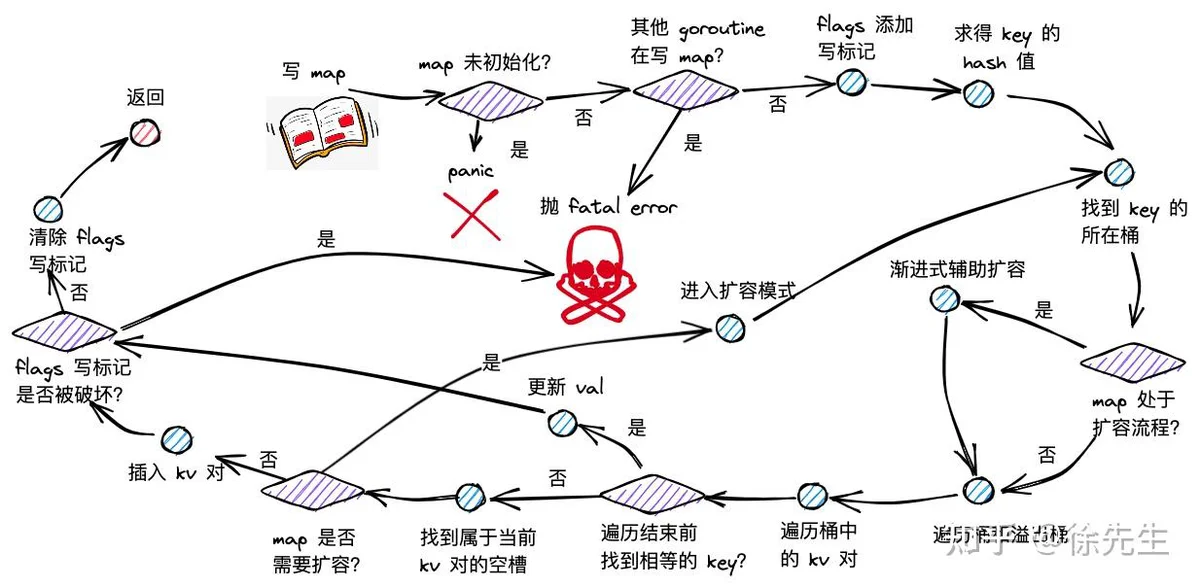
6.1 写流程梳理
map 写流程主要分为以下几步:
(1)根据 key 取 hash 值;
(2)根据 hash 值对桶数组取模,确定所在的桶;
(3)倘若 map 处于扩容,则迁移命中的桶,帮助推进渐进式扩容;
(4)沿着桶链表依次遍历各个桶内的 key-value 对;
(5)倘若命中相同的 key,则对 value 中进行更新;
(6)倘若 key 不存在,则插入 key-value 对;
(7)倘若发现 map 达成扩容条件,则会开启扩容模式,并重新返回第(2)步.
map 写操作最终会走进 runtime/map.go 的 mapassign 方法中,下面开始阅读源码:
6.2 mapassign
func mapassign(t *maptype, h *hmap, key unsafe.Pointer) unsafe.Pointer {
if h == nil {
panic(plainError("assignment to entry in nil map"))
}
if h.flags&hashWriting != 0 {
fatal("concurrent map writes")
}
hash := t.hasher(key, uintptr(h.hash0))
h.flags ^= hashWriting
if h.buckets == nil {
h.buckets = newobject(t.bucket)
}
again:
bucket := hash & bucketMask(h.B)
if h.growing() {
growWork(t, h, bucket)
}
b := (*bmap)(add(h.buckets, bucket*uintptr(t.bucketsize)))
top := tophash(hash)
var inserti *uint8
var insertk unsafe.Pointer
var elem unsafe.Pointer
bucketloop:
for {
for i := uintptr(0); i < bucketCnt; i++ {
if b.tophash[i] != top {
if isEmpty(b.tophash[i]) && inserti == nil {
inserti = &b.tophash[i]
insertk = add(unsafe.Pointer(b), dataOffset+i*uintptr(t.keysize))
elem = add(unsafe.Pointer(b), dataOffset+bucketCnt*uintptr(t.keysize)+i*uintptr(t.elemsize))
}
if b.tophash[i] == emptyRest {
break bucketloop
}
continue
}
k := add(unsafe.Pointer(b), dataOffset+i*uintptr(t.keysize))
if t.indirectkey() {
k = *((*unsafe.Pointer)(k))
}
if !t.key.equal(key, k) {
continue
}
if t.needkeyupdate() {
typedmemmove(t.key, k, key)
}
elem = add(unsafe.Pointer(b), dataOffset+bucketCnt*uintptr(t.keysize)+i*uintptr(t.elemsize))
goto done
}
ovf := b.overflow(t)
if ovf == nil {
break
}
b = ovf
}
if !h.growing() && (overLoadFactor(h.count+1, h.B) || tooManyOverflowBuckets(h.noverflow, h.B)) {
hashGrow(t, h)
goto again
}
if inserti == nil {
newb := h.newoverflow(t, b)
inserti = &newb.tophash[0]
insertk = add(unsafe.Pointer(newb), dataOffset)
elem = add(insertk, bucketCnt*uintptr(t.keysize))
}
if t.indirectkey() {
kmem := newobject(t.key)
*(*unsafe.Pointer)(insertk) = kmem
insertk = kmem
}
if t.indirectelem() {
vmem := newobject(t.elem)
*(*unsafe.Pointer)(elem) = vmem
}
typedmemmove(t.key, insertk, key)
*inserti = top
h.count++
done:
if h.flags&hashWriting == 0 {
fatal("concurrent map writes")
}
h.flags &^= hashWriting
if t.indirectelem() {
elem = *((*unsafe.Pointer)(elem))
}
retur(1)写操作时,倘若 map 未初始化,直接 panic;
if h == nil {
panic(plainError("assignment to entry in nil map"))
}(2)倘若其他 goroutine 在进行写或删操作,抛出并发写 fatal error;
if h.flags&hashWriting != 0 {
fatal("concurrent map writes")
}(3)通过 maptype.hasher() 方法求得 key 对应的 hash 值;
hash := t.hasher(key, uintptr(h.hash0))(4)通过异或位运算,将 map.flags 的第 3 个 bit 位置为 1,添加写标记;
h.flags ^= hashWriting(5)倘若 map 的桶数组 buckets 未空,则对其进行初始化;
if h.buckets == nil {
h.buckets = newobject(t.bucket)
}(6)找到当前 key 对应的桶索引 bucket;
bucket := hash & bucketMask(h.B)(7)倘若发现当前 map 正处于扩容过程,则帮助其渐进扩容,具体内容在第 9 节中再作展开;
if h.growing() {
growWork(t, h, bucket)
}(8)从 map 的桶数组 buckets 出发,结合桶索引和桶容量大小,进行地址偏移,获得对应桶 b;
b := (*bmap)(add(h.buckets, bucket*uintptr(t.bucketsize)))(9)取得 key 的高 8 位 tophash:
top := tophash(hash)(10)提前声明好的三个指针,用于指向存放 key-value 的空槽:
inserti:tophash 拟插入位置;
insertk:key 拟插入位置 ;
elem:val 拟插入位置;
var inserti *uint8
var insertk unsafe.Pointer
var elem unsafe.Pointer(11)开启两层 for 循环,外层沿着桶链表依次遍历,内层依次遍历桶内的 key-value 对:
bucketloop:
for {
for i := uintptr(0); i < bucketCnt; i++ {
// ...
}
ovf := b.overflow(t)
if ovf == nil {
break
}
b = ovf
}(12)倘若 key 的 tophash 和当前位置 tophash 不同,则会尝试将 inserti、insertk elem 调整指向首个空位,用于后续的插入操作.
倘若发现当前位置 tophash 标识为 emtpyRest(0),则说明当前桶链表后续位置都未空,无需继续遍历,直接 break 遍历流程即可.
if b.tophash[i] != top {
if isEmpty(b.tophash[i]) && inserti == nil {
inserti = &b.tophash[i]
insertk = add(unsafe.Pointer(b), dataOffset+i*uintptr(t.keysize))
elem = add(unsafe.Pointer(b), dataOffset+bucketCnt*uintptr(t.keysize)+i*uintptr(t.elemsize))
}
if b.tophash[i] == emptyRest {
break bucketloop
}
continue
}
}倘若桶中某个位置的 tophash 标识为 emptyOne(1),说明当前位置未放入元素,倘若为 emptyRest(0),说明包括当前位置在内,此后的位置都为空.
const emptyRest = 0
const emptyOne = 1
func isEmpty(x uint8) bool {
return x <= emptyOne
}(13)倘若找到了相等的 key,则执行更新操作,并且直接跳转到方法的 done 标志位处,进行收尾处理;
k := add(unsafe.Pointer(b), dataOffset+i*uintptr(t.keysize))
if t.indirectkey() {
k = *((*unsafe.Pointer)(k))
}
if !t.key.equal(key, k) {
continue
}
elem = add(unsafe.Pointer(b), dataOffset+bucketCnt*uintptr(t.keysize)+i*uintptr(t.elemsize))
goto done(14)倘若没找到相等的 key,会在执行插入操作前,判断 map 是否需要开启扩容模式. 这部分内容在第 9 节中作展开.
倘若需要扩容,会在开启扩容模式后,跳转回 again 标志位,重新开始桶的定位以及遍历流程.
if !h.growing() && (overLoadFactor(h.count+1, h.B) || tooManyOverflowBuckets(h.noverflow, h.B)) {
hashGrow(t, h)
goto again
}(15)倘若遍历完桶链表,都没有为当前待插入的 key-value 对找到空位,则会创建一个新的溢出桶,挂载在桶链表的尾部,并将 inserti、insertk、elem 指向溢出桶的首个空位:
if inserti == nil {
newb := h.newoverflow(t, b)
inserti = &newb.tophash[0]
insertk = add(unsafe.Pointer(newb), dataOffset)
elem = add(insertk, bucketCnt*uintptr(t.keysize))
}创建溢出桶时:
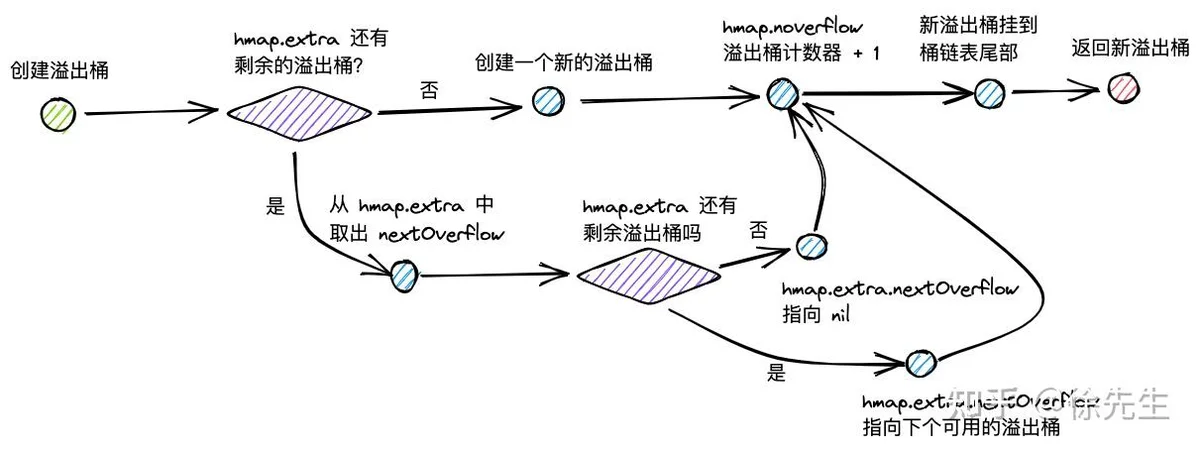
I 倘若 hmap.extra 中还有剩余可用的溢出桶,则直接获取 hmap.extra.nextOverflow,并将 nextOverflow 调整指向下一个空闲可用的溢出桶;
II 倘若 hmap 已经没有空闲溢出桶了,则创建一个新的溢出桶.
III hmap 的溢出桶数量 hmap.noverflow 累加 1;
IV 将新获得的溢出桶添加到原桶链表的尾部;
V 返回溢出桶.
func (h *hmap) newoverflow(t *maptype, b *bmap) *bmap {
var ovf *bmap
if h.extra != nil && h.extra.nextOverflow != nil {
ovf = h.extra.nextOverflow
if ovf.overflow(t) == nil {
h.extra.nextOverflow = (*bmap)(add(unsafe.Pointer(ovf), uintptr(t.bucketsize)))
} else {
ovf.setoverflow(t, nil)
h.extra.nextOverflow = nil
}
} else {
ovf = (*bmap)(newobject(t.bucket))
}
h.incrnoverflow()
if t.bucket.ptrdata == 0 {
h.createOverflow()
*h.extra.overflow = append(*h.extra.overflow, ovf)
}
b.setoverflow(t, ovf)
return ovf
}(16)将 tophash、key、value 插入到取得空位中,并且将 map 的 key-value 对计数器 count 值加 1;
if t.indirectkey() {
kmem := newobject(t.key)
*(*unsafe.Pointer)(insertk) = kmem
insertk = kmem
}
if t.indirectelem() {
vmem := newobject(t.elem)
*(*unsafe.Pointer)(elem) = vmem
}
typedmemmove(t.key, insertk, key)
*inserti = top
h.count++(17)收尾环节,再次校验是否有其他协程并发写,倘若有,则抛 fatal error. 将 hmap.flags 中的写标记抹去,然后退出方法.
done:
if h.flags&hashWriting == 0 {
fatal("concurrent map writes")
}
h.flags &^= hashWriting
if t.indirectelem() {
elem = *((*unsafe.Pointer)(elem))
}
return elem7 删流程
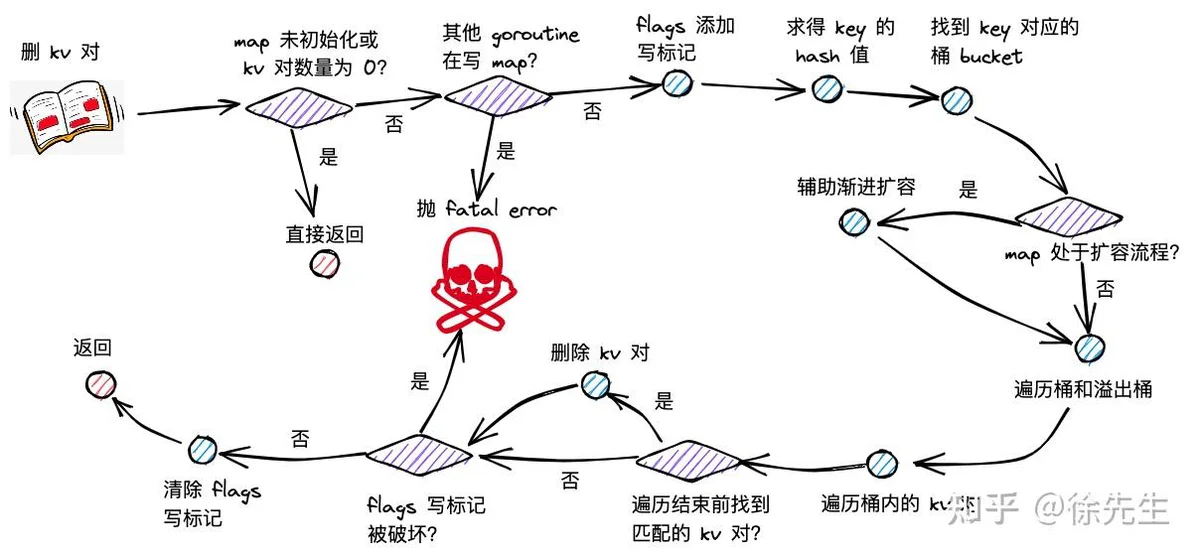
7.1 删除 kv 对流程梳理
map 删楚 kv 对流程主要分为以下几步:
(1)根据 key 取 hash 值;
(2)根据 hash 值对桶数组取模,确定所在的桶;
(3)倘若 map 处于扩容,则迁移命中的桶,帮助推进渐进式扩容;
(4)沿着桶链表依次遍历各个桶内的 key-value 对;
(5)倘若命中相同的 key,删除对应的 key-value 对;并将当前位置的 tophash 置为 emptyOne,表示为空;
(6)倘若当前位置为末位,或者下一个位置的 tophash 为 emptyRest,则沿当前位置向前遍历,将毗邻的 emptyOne 统一更新为 emptyRest.
map 删操作最终会走进 runtime/map.go 的 mapdelete 方法中,下面开始阅读源码:
7.2 mapdelete
func mapdelete(t *maptype, h *hmap, key unsafe.Pointer) {
if h == nil || h.count == 0 {
return
}
if h.flags&hashWriting != 0 {
fatal("concurrent map writes")
}
hash := t.hasher(key, uintptr(h.hash0))
h.flags ^= hashWriting
bucket := hash & bucketMask(h.B)
if h.growing() {
growWork(t, h, bucket)
}
b := (*bmap)(add(h.buckets, bucket*uintptr(t.bucketsize)))
bOrig := b
top := tophash(hash)
search:
for ; b != nil; b = b.overflow(t) {
for i := uintptr(0); i < bucketCnt; i++ {
if b.tophash[i] != top {
if b.tophash[i] == emptyRest {
break search
}
continue
}
k := add(unsafe.Pointer(b), dataOffset+i*uintptr(t.keysize))
k2 := k
if t.indirectkey() {
k2 = *((*unsafe.Pointer)(k2))
}
if !t.key.equal(key, k2) {
continue
}
// Only clear key if there are pointers in it.
if t.indirectkey() {
*(*unsafe.Pointer)(k) = nil
} else if t.key.ptrdata != 0 {
memclrHasPointers(k, t.key.size)
}
e := add(unsafe.Pointer(b), dataOffset+bucketCnt*uintptr(t.keysize)+i*uintptr(t.elemsize))
if t.indirectelem() {
*(*unsafe.Pointer)(e) = nil
} else if t.elem.ptrdata != 0 {
memclrHasPointers(e, t.elem.size)
} else {
memclrNoHeapPointers(e, t.elem.size)
}
b.tophash[i] = emptyOne
if i == bucketCnt-1 {
if b.overflow(t) != nil && b.overflow(t).tophash[0] != emptyRest {
goto notLast
}
} else {
if b.tophash[i+1] != emptyRest {
goto notLast
}
}
for {
b.tophash[i] = emptyRest
if i == 0 {
if b == bOrig {
break
}
c := b
for b = bOrig; b.overflow(t) != c; b = b.overflow(t) {
}
i = bucketCnt - 1
} else {
i--
}
if b.tophash[i] != emptyOne {
break
}
}
notLast:
h.count--
if h.count == 0 {
h.hash0 = fastrand()
}
break search
}
}
if h.flags&hashWriting == 0 {
fatal("concurrent map writes")
}
h.flags &^= hashWritin(1)倘若 map 未初始化或者内部 key-value 对数量为 0,删除时不会报错,直接返回;
if h == nil || h.count == 0 {
return
}(2)倘若存在其他 goroutine 在进行写或删操作,抛出并发写的 fatal error;
if h.flags&hashWriting != 0 {
fatal("concurrent map writes")
}(3)通过 maptype.hasher() 方法求得 key 对应的 hash 值;
hash := t.hasher(key, uintptr(h.hash0))(4)通过异或位运算,将 map.flags 的第 3 个 bit 位置为 1,添加写标记;
h.flags ^= hashWriting(5)找到当前 key 对应的桶索引 bucket;
bucket := hash & bucketMask(h.B)(6)倘若发现当前 map 正处于扩容过程,则帮助其渐进扩容,具体内容在第 9 节中再作展开;
if h.growing() {
growWork(t, h, bucket)
}(7)从 map 的桶数组 buckets 出发,结合桶索引和桶容量大小,进行地址偏移,获得对应桶 b,并赋值给 bOrg;
b := (*bmap)(add(h.buckets, bucket*uintptr(t.bucketsize)))
bOrig := b(8)取得 key 的高 8 位 tophash:
top := tophash(hash)(9)开启两层 for 循环,外层沿着桶链表依次遍历,内层依次遍历桶内的 key-value 对.
search:
for ; b != nil; b = b.overflow(t) {
for i := uintptr(0); i < bucketCnt; i++ {
// ...
}
}(10)遍历时,倘若发现当前位置 tophash 值为 emptyRest,则直接结束遍历流程:
if b.tophash[i] != top {
if b.tophash[i] == emptyRest {
break search
}
continue
}(11)倘若 key 不相等,则继续遍历:
k := add(unsafe.Pointer(b), dataOffset+i*uintptr(t.keysize))
k2 := k
if t.indirectkey() {
k2 = *((*unsafe.Pointer)(k2))
}
if !t.key.equal(key, k2) {
continue
}(12)倘若 key 相等,则删除对应的 key-value 对,并且将当前位置的 tophash 置为 emptyOne:
if t.indirectkey() {
*(*unsafe.Pointer)(k) = nil
} else if t.key.ptrdata != 0 {
memclrHasPointers(k, t.key.size)
}
e := add(unsafe.Pointer(b), dataOffset+bucketCnt*uintptr(t.keysize)+i*uintptr(t.elemsize))
if t.indirectelem() {
*(*unsafe.Pointer)(e) = nil
} else if t.elem.ptrdata != 0 {
memclrHasPointers(e, t.elem.size)
} else {
memclrNoHeapPointers(e, t.elem.size)
}
b.tophash[i] = emptyOne(13)倘若当前位置不位于最后一个桶的最后一个位置,或者当前位置的后置位 tophash 不为 emptyRest,则无需向前遍历更新 tophash 标识,直接跳转到 notLast 位置即可;
if i == bucketCnt-1 {
if b.overflow(t) != nil && b.overflow(t).tophash[0] != emptyRest {
goto notLast
}
} else {
if b.tophash[i+1] != emptyRest {
goto notLast
}
}(14)向前遍历,将沿途的空位( tophash 为 emptyOne )的 tophash 都更新为 emptySet.
for {
b.tophash[i] = emptyRest
if i == 0 {
if b == bOrig {
break
}
c := b
for b = bOrig; b.overflow(t) != c; b = b.overflow(t) {
}
i = bucketCnt - 1
} else {
i--
}
if b.tophash[i] != emptyOne {
break
}
}(15)倘若成功从 map 中删除了一组 key-value 对,则将 hmap 的计数器 count 值减 1. 倘若 map 中的元素全都被删除完了,会为 map 更换一个新的随机因子 hash0.
notLast:
h.count--
if h.count == 0 {
h.hash0 = fastrand()
}
break search(16)收尾环节,再次校验是否有其他协程并发写,倘若有,则抛 fatal error. 将 hmap.flags 中的写标记抹去,然后退出方法.
if h.flags&hashWriting == 0 {
fatal("concurrent map writes")
}
h.flags &^= hashWri8 遍历流程

map 的遍历流程首先会走进 runtime/map.go 的 mapiterinit() 方法当中,初始化用于遍历的迭代器 hiter;接着会调用 runtime/map.go 的 mapiternext() 方法开启遍历流程.
8.1 迭代器数据结构
type hiter struct {
key unsafe.Pointer
elem unsafe.Pointer
t *maptype
h *hmap
buckets unsafe.Pointer
bptr *bmap
overflow *[]*bmap
oldoverflow *[]*bmap
startBucket uintptr
offset uint8
wrapped bool
B uint8
i uint8
bucket uintptr
checkBucket uintptr
}hiter 是遍历 map 时用于存放临时数据的迭代器:
(1)key:指向遍历得到 key 的指针;
(2)value:指向遍历得到 value 的指针;
(3)t:map 类型,包含了 key、value 类型大小等信息;
(4)h:map 的指针;
(5)buckets:map 的桶数组;
(6)bptr:当前遍历到的桶;
(7)overflow:新老桶数组对应的溢出桶;
(8)startBucket:遍历起始位置的桶索引;
(9)offset:遍历起始位置的 key-value 对索引;
(10)wrapped:遍历是否穿越桶数组尾端回到头部了;
(11)B:桶数组的长度指数;
(12)i:当前遍历到的 key-value 对在桶中的索引;
(13)bucket:当前遍历到的桶;
(14)checkBucket:因为扩容流程的存在,需要额外检查的桶.
8.2 mapiterinit
map 遍历流程开始时,首先会走进 runtime/map.go 的 mapiterinit() 方法当中,此时会对创建 map 迭代器 hiter,并且通过取随机数的方式,决定遍历的起始桶号,以及起始 key-value 对索引号.
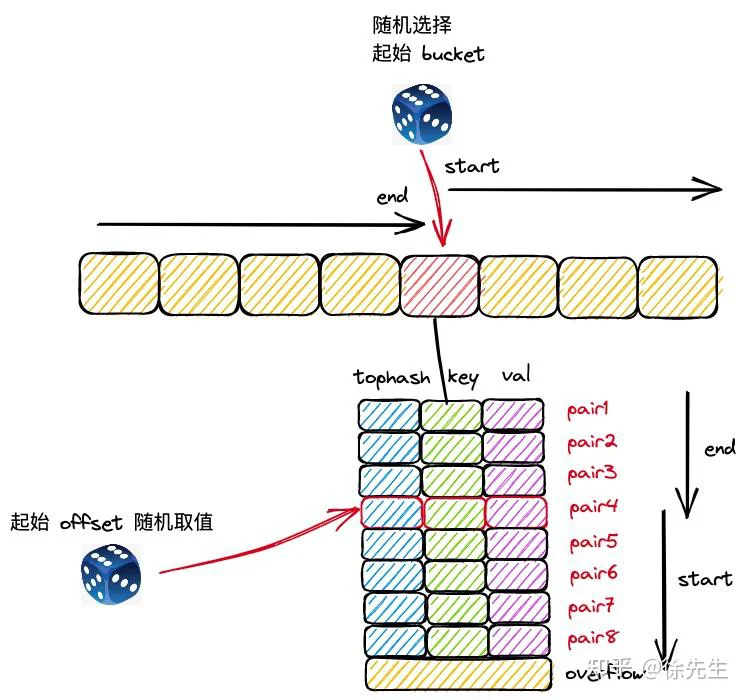
func mapiterinit(t *maptype, h *hmap, it *hiter) {
it.t = t
if h == nil || h.count == 0 {
return
}
it.h = h
it.B = h.B
it.buckets = h.buckets
if t.bucket.ptrdata == 0 {
h.createOverflow()
it.overflow = h.extra.overflow
it.oldoverflow = h.extra.oldoverflow
}
// decide where to start
var r uintptr
r = uintptr(fastrand())
it.startBucket = r & bucketMask(h.B)
it.offset = uint8(r >> h.B & (bucketCnt - 1))
// iterator state
it.bucket = it.startBucket
// Remember we have an iterator.
// Can run concurrently with another mapiterinit().
if old := h.flags; old&(iterator|oldIterator) != iterator|oldIterator {
atomic.Or8(&h.flags, iterator|oldIterator)
}
mapiternext((1)通过取随机数的方式,决定遍历时的起始桶,以及桶中起始 key-value 对的位置:
var r uintptr
r = uintptr(fastrand())
it.startBucket = r & bucketMask(h.B)
it.offset = uint8(r >> h.B & (bucketCnt - 1))
// iterator state
it.bucket = it.startB(2)完成迭代器 hiter 中各项参数的初始化后,不如 mapiternext 方法开启遍历.
8.2 mapiternext
func mapiternext(it *hiter) {
h := it.h
if h.flags&hashWriting != 0 {
fatal("concurrent map iteration and map write")
}
t := it.t
bucket := it.bucket
b := it.bptr
i := it.i
checkBucket := it.checkBucket
next:
if b == nil {
if bucket == it.startBucket && it.wrapped {
it.key = nil
it.elem = nil
return
}
if h.growing() && it.B == h.B {
oldbucket := bucket & it.h.oldbucketmask()
b = (*bmap)(add(h.oldbuckets, oldbucket*uintptr(t.bucketsize)))
if !evacuated(b) {
checkBucket = bucket
} else {
b = (*bmap)(add(it.buckets, bucket*uintptr(t.bucketsize)))
checkBucket = noCheck
}
} else {
b = (*bmap)(add(it.buckets, bucket*uintptr(t.bucketsize)))
checkBucket = noCheck
}
bucket++
if bucket == bucketShift(it.B) {
bucket = 0
it.wrapped = true
}
i = 0
}
for ; i < bucketCnt; i++ {
offi := (i + it.offset) & (bucketCnt - 1)
if isEmpty(b.tophash[offi]) || b.tophash[offi] == evacuatedEmpty {
continue
}
k := add(unsafe.Pointer(b), dataOffset+uintptr(offi)*uintptr(t.keysize))
if t.indirectkey() {
k = *((*unsafe.Pointer)(k))
}
e := add(unsafe.Pointer(b), dataOffset+bucketCnt*uintptr(t.keysize)+uintptr(offi)*uintptr(t.elemsize))
if checkBucket != noCheck && !h.sameSizeGrow() {
if checkBucket>>(it.B-1) != uintptr(b.tophash[offi]&1) {
continue
}
}
if (b.tophash[offi] != evacuatedX && b.tophash[offi] != evacuatedY) ||
!(t.reflexivekey() || t.key.equal(k, k)) {
it.key = k
if t.indirectelem() {
e = *((*unsafe.Pointer)(e))
}
it.elem = e
} else {
rk, re := mapaccessK(t, h, k)
if rk == nil {
continue // key has been deleted
}
it.key = rk
it.elem = re
}
it.bucket = bucket
if it.bptr != b { // avoid unnecessary write barrier; see issue 14921
it.bptr = b
}
it.i = i + 1
it.checkBucket = checkBucket
return
}
b = b.overflow(t)
i = 0
goto next
}(1)遍历时发现其他 goroutine 在并发写,直接抛出 fatal error:
if h.flags&hashWriting != 0 {
fatal("concurrent map iteration and map write")
}(2)开启最外圈的循环,依次遍历桶数组中的每个桶链表,通过 next 和 goto next 关键字实现循环代码块;
next:
if b == nil {
// ...
b = (*bmap)(add(it.buckets, bucket*uintptr(t.bucketsize)))
//
bucket++
if bucket == bucketShift(it.B) {
bucket = 0
it.wrapped = true
}
i = 0
}
// ...
b = b.overflow(t)
// ...
goto next
}(3)倘若已经遍历完所有的桶,重新回到起始桶为止,则直接结束方法;
if bucket == it.startBucket && it.wrapped {
it.key = nil
it.elem = nil
return
}(4)倘若 map 处于扩容流程,取桶时兼容新老桶数组的逻辑. 倘若桶处于旧桶数组且未完成迁移,需要将 checkBucket 置为当前的桶号;
if h.growing() && it.B == h.B {
oldbucket := bucket & it.h.oldbucketmask()
b = (*bmap)(add(h.oldbuckets, oldbucket*uintptr(t.bucketsize)))
if !evacuated(b) {
checkBucket = bucket
} else {
b = (*bmap)(add(it.buckets, bucket*uintptr(t.bucketsize)))
checkBucket = noCheck
}
} else {
b = (*bmap)(add(it.buckets, bucket*uintptr(t.bucketsize)))
checkBucket = noCheck
}(5)遍历的桶号加 1,倘若来到桶数组末尾,则将桶号置为 0. 将 key-value 对的遍历索引 i 置为 0.
bucket++
if bucket == bucketShift(it.B) {
bucket = 0
it.wrapped = true
}
i = 0(6)依次遍历各个桶中每个 key-value 对:
for ; i < bucketCnt; i++ {
// ...
return
}(7)倘若遍历到的桶属于旧桶数组未迁移完成的桶,需要按照其在新桶中的顺序完成遍历. 比如,增量扩容流程中,旧桶中的 key-value 对最终应该被分散迁移到新桶数组的 x、y 两个区域,则此时遍历时,哪怕 key-value 对仍存留在旧桶中未完成迁移,遍历时也应该严格按照其在新桶数组中的顺序来执行.
if checkBucket != noCheck && !h.sameSizeGrow() {
if checkBucket>>(it.B-1) != uintptr(b.tophash[offi]&1) {
continue
}
}(8)执行 mapaccessK 方法,基于读流程方法获取 key-value 对,通过迭代 hiter 的 key、value 指针进行接收,用于对用户的遍历操作进行响应:
rk, re := mapaccessK(t, h, k)
if rk == nil {
continue // key has been deleted
}
it.key = rk
it.elem = re9 扩容流程
9.1 扩容类型
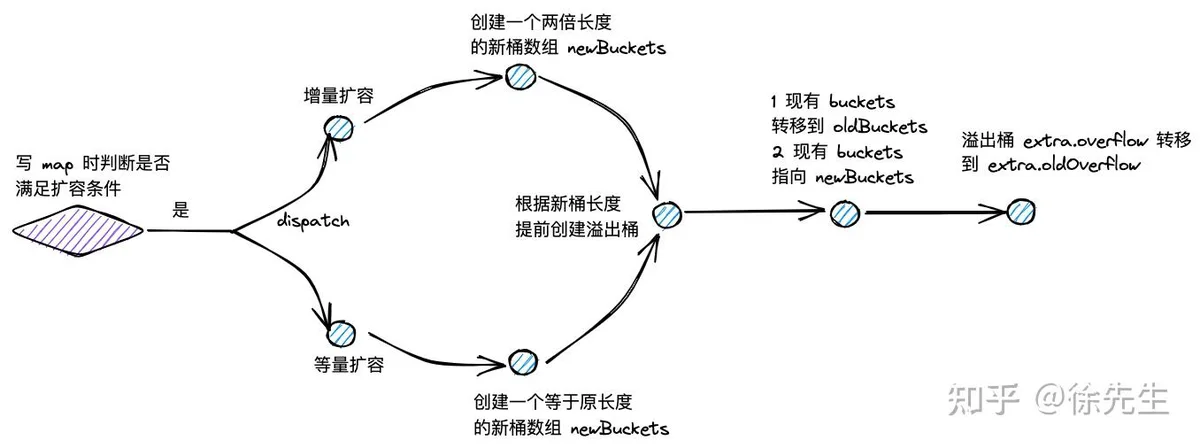
map 的扩容类型分为两类,一类叫做增量扩容,一类叫做等量扩容.
(1)增量扩容
表现:扩容后,桶数组的长度增长为原长度的 2 倍;
目的:降低每个桶中 key-value 对的数量,优化 map 操作的时间复杂度.
(2)等量扩容
表现:扩容后,桶数组的长度和之前保持一致;但是溢出桶的数量会下降.
目的:提高桶主体结构的数据填充率,减少溢出桶数量,避免发生内存泄漏.
9.2 何时扩容
(1)只有 map 的写流程可能开启扩容模式;
(2)写 map 新插入 key-value 对之前,会发起是否需要扩容的逻辑判断:
func mapassign(t *maptype, h *hmap, key unsafe.Pointer) unsafe.Pointer {
// ...
if !h.growing() && (overLoadFactor(h.count+1, h.B) || tooManyOverflowBuckets(h.noverflow, h.B)) {
hashGrow(t, h)
goto again
}
// ...
}(3)根据 hmap 的 oldbuckets 是否空,可以判断 map 此前是否已开启扩容模式:
func (h *hmap) growing() bool {
return h.oldbuckets != nil
}(4)倘若此前未进入扩容模式,且 map 中 key-value 对的数量超过 8 个,且大于桶数组长度的 6.5 倍,则进入增量扩容:
const(
loadFactorNum = 13
loadFactorDen = 2
bucketCnt = 8
)
func overLoadFactor(count int, B uint8) bool {
return count > bucketCnt && uintptr(count) > loadFactorNum*(bucketShift(B)/loadFactorDen)
}(5)倘若溢出桶的数量大于 2^B 个(即桶数组的长度;B 大于 15 时取15),则进入等量扩容:
func tooManyOverflowBuckets(noverflow uint16, B uint8) bool {
if B > 15 {
B = 15
}
return noverflow >= uint16(1)<<(B&15)
}9.3 如何开启扩容模式
开启扩容模式的方法位于 runtime/map.go 的 hashGrow 方法中:
func hashGrow(t *maptype, h *hmap) {
bigger := uint8(1)
if !overLoadFactor(h.count+1, h.B) {
bigger = 0
h.flags |= sameSizeGrow
}
oldbuckets := h.buckets
newbuckets, nextOverflow := makeBucketArray(t, h.B+bigger, nil)
flags := h.flags &^ (iterator | oldIterator)
if h.flags&iterator != 0 {
flags |= oldIterator
}
// commit the grow (atomic wrt gc)
h.B += bigger
h.flags = flags
h.oldbuckets = oldbuckets
h.buckets = newbuckets
h.nevacuate = 0
h.noverflow = 0
if h.extra != nil && h.extra.overflow != nil {
// Promote current overflow buckets to the old generation.
if h.extra.oldoverflow != nil {
throw("oldoverflow is not nil")
}
h.extra.oldoverflow = h.extra.overflow
h.extra.overflow = nil
}
if nextOverflow != nil {
if h.extra == nil {
h.extra = new(mapextra)
}
h.extra.nextOverflow = nextOverflow
}(1)倘若是增量扩容,bigger 值取 1;倘若是等量扩容,bigger 值取 0,并将 hmap.flags 的第 4 个 bit 位置为 1,标识当前处于等量扩容流程.
const sameSizeGrow = 8
bigger := uint8(1)
if !overLoadFactor(h.count+1, h.B) {
bigger = 0
h.flags |= sameSizeGrow
}(2)将原桶数组赋值给 oldBuckets,并创建新的桶数组和一批新的溢出桶.
此处会通过变量 bigger,实现不同扩容模式下,新桶数组长度的区别处理.
oldbuckets := h.buckets
newbuckets, nextOverflow := makeBucketArray(t, h.B+bigger, nil)(3)更新 hmap 的桶数组长度指数 B,flag 标识,并将新、老桶数组赋值给 hmap.oldBuckets 和 hmap.buckets;扩容迁移进度 hmap.nevacuate 标记为 0;新桶数组的溢出桶数量 hmap.noverflow 置为 0.
flags := h.flags &^ (iterator | oldIterator)
if h.flags&iterator != 0 {
flags |= oldIterator
}
// commit the grow (atomic wrt gc)
h.B += bigger
h.flags = flags
h.oldbuckets = oldbuckets
h.buckets = newbuckets
h.nevacuate = 0
h.noverflow = 0(4)将原本存量可用的溢出桶赋给 hmap.extra.oldoverflow;倘若存在下一个可用的溢出桶,赋给 hmap.extra.nextOverflow.
if h.extra != nil && h.extra.overflow != nil {
h.extra.oldoverflow = h.extra.overflow
h.extra.overflow = nil
}
if nextOverflow != nil {
if h.extra == nil {
h.extra = new(mapextra)
}
h.extra.nextOverflow = nextOverflow
}9.4 扩容迁移规则
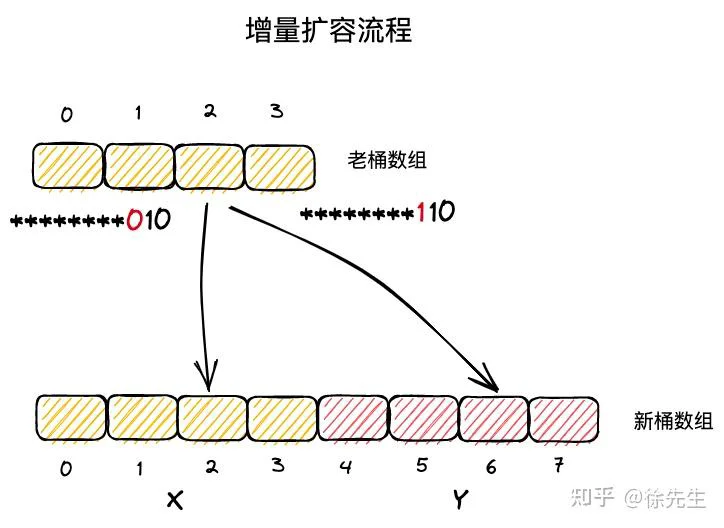
(1)在等量扩容中,新桶数组长度与原桶数组相同;
(2)key-value 对在新桶数组和老桶数组的中的索引号保持一致;
(3)在增量扩容中,新桶数组长度为原桶数组的两倍;
(4)把新桶数组中桶号对应于老桶数组的区域称为 x 区域,新扩展的区域称为 y 区域.
(5)实际上,一个 key 属于哪个桶,取决于其 hash 值对桶数组长度取模得到的结果,因此依赖于其低位的 hash 值结果.;
(6)在增量扩容流程中,新桶数组的长度会扩展一位,假定 key 原本从属的桶号为 i,则在新桶数组中从属的桶号只可能是 i (x 区域)或者 i + 老桶数组长度(y 区域);
(7)当 key 低位 hash 值向左扩展一位的 bit 位为 0,则应该迁往 x 区域的 i 位置;倘若该 bit 位为 1,应该迁往 y 区域对应的 i + 老桶数组长度的位置.
9.5 渐进式扩容
map 采用的是渐进扩容的方式,避免因为一次性的全量数据迁移引发性能抖动.
当每次触发写、删操作时,会为处于扩容流程中的 map 完成两组桶的数据迁移:
(1)一组桶是当前写、删操作所命中的桶;
(2)另一组桶是,当前未迁移的桶中,索引最小的那个桶.
func growWork(t *maptype, h *hmap, bucket uintptr) {
// make sure we evacuate the oldbucket corresponding
// to the bucket we're about to use
evacuate(t, h, bucket&h.oldbucketmask())
// evacuate one more oldbucket to make progress on growing
if h.growing() {
evacuate(t, h, h.nevacuate)
}
}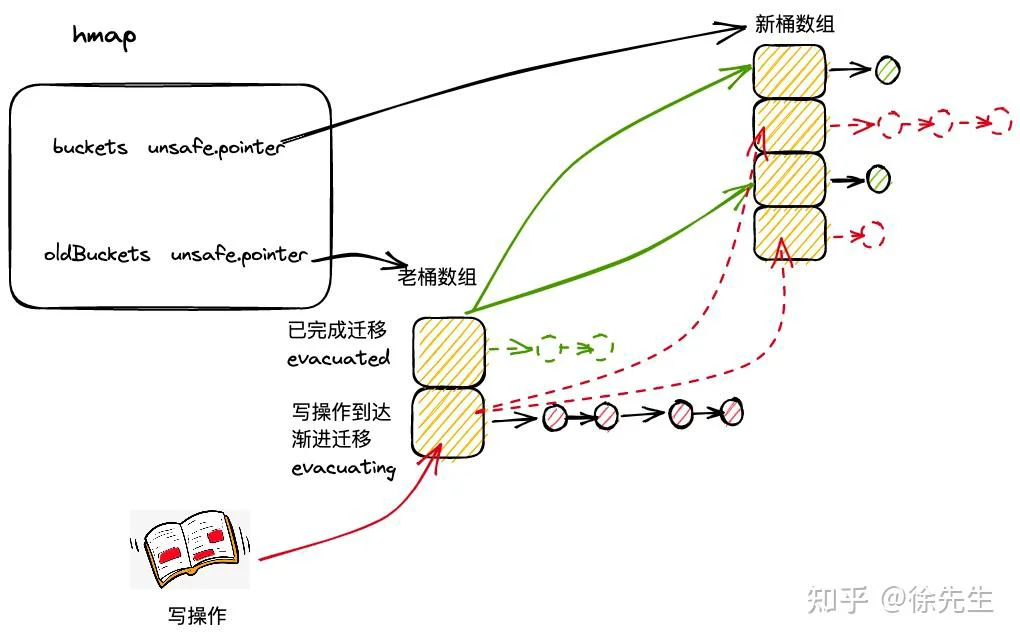
数据迁移的逻辑位于 runtime/map.go 的 evacuate 方法当中:
func evacuate(t *maptype, h *hmap, oldbucket uintptr) {
// 入参中,oldbucket 为当前要迁移的桶在旧桶数组中的索引
// 获取到待迁移桶的内存地址 b
b := (*bmap)(add(h.oldbuckets, oldbucket*uintptr(t.bucketsize)))
// 获取到旧桶数组的容量 newbit
newbit := h.noldbuckets()
// evacuated 方法判断出桶 b 是否已经迁移过了,未迁移过,才进入此 if 分支进行迁移处理
if !evacuated(b) {
// 通过一个二元数组 xy 指向当前桶可能迁移到的目的桶
// x = xy[0],代表新桶数组中索引和旧桶数组一致的桶
// y = xy[1],代表新桶数组中,索引为原索引加上旧桶容量的桶,只在增量扩容中会使用到
var xy [2]evacDst
x := &xy[0]
x.b = (*bmap)(add(h.buckets, oldbucket*uintptr(t.bucketsize)))
x.k = add(unsafe.Pointer(x.b), dataOffset)
x.e = add(x.k, bucketCnt*uintptr(t.keysize))
// 只有进入增量扩容的分支,才需要对 y 进行初始化
if !h.sameSizeGrow() {
// Only calculate y pointers if we're growing bigger.
// Otherwise GC can see bad pointers.
y := &xy[1]
y.b = (*bmap)(add(h.buckets, (oldbucket+newbit)*uintptr(t.bucketsize)))
y.k = add(unsafe.Pointer(y.b), dataOffset)
y.e = add(y.k, bucketCnt*uintptr(t.keysize))
}
// 外层 for 循环,遍历桶 b 和对应的溢出桶
for ; b != nil; b = b.overflow(t) {
// k,e 分别记录遍历桶时,当前的 key 和 value 的指针
k := add(unsafe.Pointer(b), dataOffset)
e := add(k, bucketCnt*uintptr(t.keysize))
// 遍历桶内的 key-value 对
for i := 0; i < bucketCnt; i, k, e = i+1, add(k, uintptr(t.keysize)), add(e, uintptr(t.elemsize)) {
top := b.tophash[i]
if isEmpty(top) {
b.tophash[i] = evacuatedEmpty
continue
}
if top < minTopHash {
throw("bad map state")
}
k2 := k
if t.indirectkey() {
k2 = *((*unsafe.Pointer)(k2))
}
var useY uint8
if !h.sameSizeGrow() {
// Compute hash to make our evacuation decision (whether we need
// to send this key/elem to bucket x or bucket y).
hash := t.hasher(k2, uintptr(h.hash0))
if hash&newbit != 0 {
useY = 1
}
}
b.tophash[i] = evacuatedX + useY // evacuatedX + 1 == evacuatedY
dst := &xy[useY] // evacuation destination
if dst.i == bucketCnt {
dst.b = h.newoverflow(t, dst.b)
dst.i = 0
dst.k = add(unsafe.Pointer(dst.b), dataOffset)
dst.e = add(dst.k, bucketCnt*uintptr(t.keysize))
}
dst.b.tophash[dst.i&(bucketCnt-1)] = top // mask dst.i as an optimization, to avoid a bounds check
if t.indirectkey() {
*(*unsafe.Pointer)(dst.k) = k2 // copy pointer
} else {
typedmemmove(t.key, dst.k, k) // copy elem
}
if t.indirectelem() {
*(*unsafe.Pointer)(dst.e) = *(*unsafe.Pointer)(e)
} else {
typedmemmove(t.elem, dst.e, e)
}
dst.i++
dst.k = add(dst.k, uintptr(t.keysize))
dst.e = add(dst.e, uintptr(t.elemsize))
}
}
// Unlink the overflow buckets & clear key/elem to help GC.
if h.flags&oldIterator == 0 && t.bucket.ptrdata != 0 {
b := add(h.oldbuckets, oldbucket*uintptr(t.bucketsize))
// Preserve b.tophash because the evacuation
// state is maintained there.
ptr := add(b, dataOffset)
n := uintptr(t.bucketsize) - dataOffset
memclrHasPointers(ptr, n)
}
}
if oldbucket == h.nevacuate {
advanceEvacuationMark(h, t, newbit)
}
}
func (h *hmap) noldbuckets() uintptr {
oldB := h.B
if !h.sameSizeGrow() {
oldB--
}
return bucketShift(oldB)(1)从老桶数组中获取到待迁移的桶 b;
b := (*bmap)(add(h.oldbuckets, oldbucket*uintptr(t.bucketsize)))(2)获取到老桶数组的长度 newbit;
newbit := h.noldbuckets()(3)倘若当前桶已经完成了迁移,则无需处理;
(4)创建一个二元数组 xy,分别承载 x 区域和 y 区域(含义定义见 9.4 小节)中的新桶位置,用于接受来自老桶数组的迁移数组;只有在增量扩容的流程中,才存在 y 区域,因此才需要对 xy 中的 y 进行定义;
var xy [2]evacDst
x := &xy[0]
x.b = (*bmap)(add(h.buckets, oldbucket*uintptr(t.bucketsize)))
x.k = add(unsafe.Pointer(x.b), dataOffset)
x.e = add(x.k, bucketCnt*uintptr(t.keysize))
if !h.sameSizeGrow() {
y := &xy[1]
y.b = (*bmap)(add(h.buckets, (oldbucket+newbit)*uintptr(t.bucketsize)))
y.k = add(unsafe.Pointer(y.b), dataOffset)
y.e = add(y.k, bucketCnt*uintptr(t.keysize))
}(5)开启两层 for 循环,外层遍历桶链表,内层遍历每个桶中的 key-value 对:
for ; b != nil; b = b.overflow(t) {
k := add(unsafe.Pointer(b), dataOffset)
e := add(k, bucketCnt*uintptr(t.keysize))
for i := 0; i < bucketCnt; i, k, e = i+1, add(k, uintptr(t.keysize)), add(e, uintptr(t.elemsize)) {
// ...
}
}(6)取每个位置的 tophash 值进行判断,倘若当前是个空位,则将当前位置 tophash 值置为 evacuatedEmpty,开始遍历下一个位置:
top := b.tophash[i]
if isEmpty(top) {
b.tophash[i] = evacuatedEmpty
continue
}(7)基于 9.4 的规则,寻找到迁移的目的桶;
const evacuatedX = 2
const evacuatedY = 3
k2 := k
var useY uint8
if !h.sameSizeGrow() {
hash := t.hasher(k2, uintptr(h.hash0))
if hash&newbit != 0 {
useY = 1
}
}
b.tophash[i] = evacuatedX + useY // evacuatedX + 1 == evacuatedY
dst := &xy[useY]其中目的桶的类型定义如下:
type evacDst struct {
b *bmap // current destination bucket
i int // key/elem index into b
k unsafe.Pointer // pointer to current key storage
e unsafe.Pointer // pointer to current elem storage
}I evacDst.b:目的地的所在桶;
II evacDst.i:即将入桶的 key-value 对在桶中的索引;
III evacDst.k:入桶 key 的存储指针;
IV evacDst.e:入桶 value 的存储指针.
(8)将 key-value 对迁移到目的桶中,并且更新目的桶结构内几个指针的指向:
if dst.i == bucketCnt {
dst.b = h.newoverflow(t, dst.b)
dst.i = 0
dst.k = add(unsafe.Pointer(dst.b), dataOffset)
dst.e = add(dst.k, bucketCnt*uintptr(t.keysize))
}
dst.b.tophash[dst.i&(bucketCnt-1)] = top // mask dst.i as an optimization, to avoid a bounds check
if t.indirectkey() {
*(*unsafe.Pointer)(dst.k) = k2 // copy pointer
} else {
typedmemmove(t.key, dst.k, k) // copy elem
}
if t.indirectelem() {
*(*unsafe.Pointer)(dst.e) = *(*unsafe.Pointer)(e)
} else {
typedmemmove(t.elem, dst.e, e)
}
dst.i++
dst.k = add(dst.k, uintptr(t.keysize))
dst.e = add(dst.e, uintptr(t.elemsize(9)倘若当前迁移的桶是旧桶数组未迁移的桶中索引最小的一个,则 hmap.nevacuate 累加 1.
倘若已经迁移完所有的旧桶,则会确保 hmap.flags 中,等量扩容的标识位被置为 0.
if oldbucket == h.nevacuate {
advanceEvacuationMark(h, t, newbit)
}
func advanceEvacuationMark(h *hmap, t *maptype, newbit uintptr) {
h.nevacuate++
// ...
if h.nevacuate == newbit { // newbit == # of oldbuckets
h.oldbuckets = nil
if h.extra != nil {
h.extra.oldoverflow = nil
}
h.flags &^= sameSizeGrow
}
}文末小广告:
欢迎老板们关注我的个人公众号:小徐先生的编程世界
我会不定期更新个人纯原创的编程技术博客,技术栈以 go 语言为主,让我们一起点亮更多的编程技能树吧!
